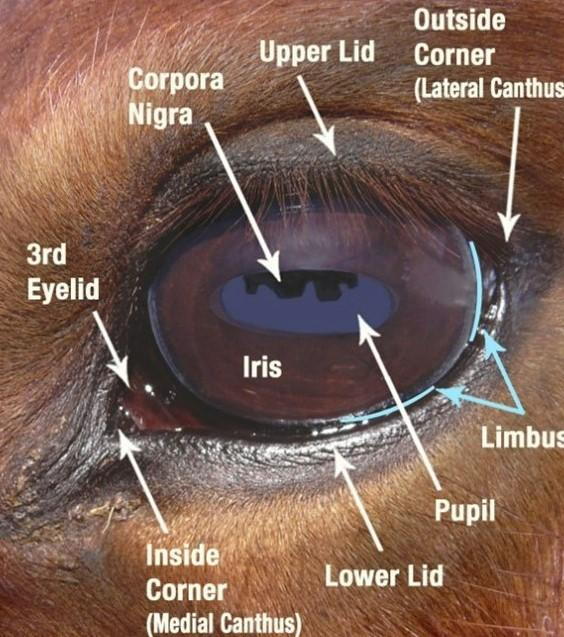
Horses have some of the largest eyes of all land mammals with a diameter of approximately 2 inches! These large eyes and their positioning on their head allow them to see nearly 360* around their body. Unfortunately this size and positioning leads them to easily cause damage to their eyes. Especially during the summer time, its important to keep an eye (pun intended) on their eyes. Make sure you are removing fly masks daily to see whats going on underneath.
Signs that your horse may be having an eye emergency include squinting, swelling of the eyelids, excessive discharge, purulent discharge, light sensitivity, or lacerations to or around the eye. These warrant a call to your veterinarian. The diagram below shows common terminology about the eye to help you describe your emergency to the veterinarian.
The most common eye emergencies we see are corneal ulcers. Corneal ulcers can occur with any trauma to the cornea of the eye. Severity of the ulcer is determined by how deep the trauma goes. Simple, superficial ulcers only affect the top part of the cornea. These ulcers can heal quickly in 3-5 days with treatment. Deeper ulcers are more prone to infection, allowing debris and bacteria to be trapped within the abrasion. These ulcers can require weeks of treatment or longer if they are left untreated and infection is allowed to brew.
Eyelid lacerations are another common injury of the eye. A fully functional eyelid is important for the health of the eye. The eyelid spreads tears over the surface of the eye and removes dust and debris. With a tear in the eyelid or improper healing of the eyelid, horses can be prone to dry eyes or ulcerations from debris or from the eyelid itself. Prompt suturing of the eyelid is imperative to ensure it heals properly. Eyelid lacerations can be prevented by ensuring the J- shaped hooks on water buckets are covered and not gapping, as water buckets are the most common place that horses tear their eyelids.
An important disease of the eye, especially in the sunny state of Colorado, is ocular squamous cell carcinoma. UV exposure is a known risk factor. Horses with lack of pigment around their eyes are at a greater risk. Tumors grow quickly and are locally invasive. These tumors are best prevented by always wearing UV protective fly masks when in the sun, especially for horses with pink skin around their eyes. Tumors can grow on the cornea, conjunctiva, limbus, eyelids and third eyelids. The lesions initially have a rough appearance and are pink in color, they grow quickly so it is important to treat them while they are small.
As prey animals, horses rely on their eyes to navigate their environment. Take care to monitor your horses eyes frequently and call your veterinarian with any questions or concerns.
